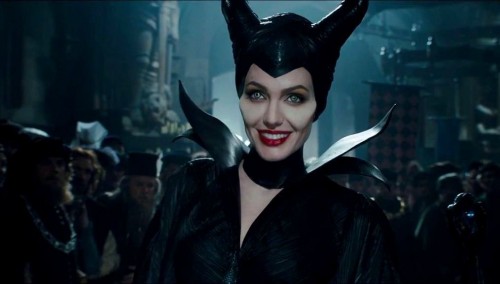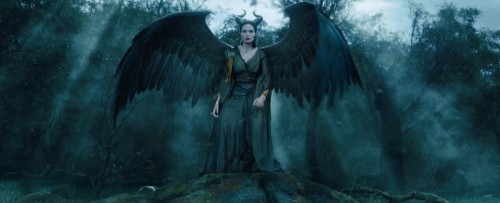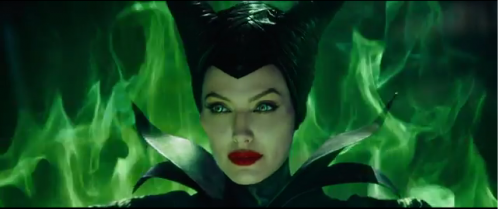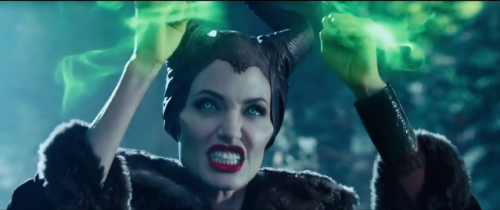This is a guest post by Melissa Cordner.
***Sole warning: contains all the spoilers.***
Reviews and friends will tell you that Maleficent was predictable, at times slow, and seemed to be primarily an excuse for the artists to show off their CG skills (that dragon though!). In terms of action-based plotlines, this is fair, but those who are bored by the film are overlooking one key factor: character development. Maleficent is a classic stereotypical “total bitch”—and THAT’S PORTRAYED AS A GOOD THING.
Maleficent was a sweet little girl, adored by her community and brave enough to defend it peaceably. She fell in love, as we are prone to do, and had her heart broken when the object of her affections left to chase fame and fortune, as we are also prone to do. This heartbreak made her cautious, but it did not destroy her. No, it was when he came back, soothed away the pain of years with his sweet talk and cuddles, and then drugged her and brutally hacked off and stole her wings, that she went a little crazy with pain and rage.

The importance of the wing theft seems a little underplayed in the film; at no point does Maleficent come out and say “the person I was in love with broke my body and spirit by taking away my main source of pride, mobility, and identity.” She spells it out a little for Aurora when she explains that her wings never faltered and were always dependable, but that doesn’t quite get to the heart of it either. On one level, her wings were what made her a fairy and made her the protector of the moors; without them, she is landlocked and crippled, incapable of work and even play. This would destroy anyone, but the fact that her wings were stolen not in battle but under the guise of romantic love adds another more complicated layer to the trauma. This man felt entitled to her body; he felt it fair to drug her and take what he wanted with no respect for what she wanted or needed or how she would survive afterwards. He took away her identity, her pride in her body, and her livelihood. He never asked permission, he never apologized, and she was left with trust in nothing and no one—not even herself.
It is interesting to note that he could not bring himself to kill her, but chose to cause her a lifetime of pain and suffering instead. Like Maleficent in the Sleeping Beauty saga, Stefan is easy to read as evil and malicious; however, we see he still has a bit of compassion when he can’t bring himself to drive the blade into her back. Of course he still destroys her in every way possible by tearing off her wings; does this make him better, or worse, than a murderer? He also could have used the knife and let her bleed to death from the experience but chose instead a chain which (we can guess) was made of iron and therefore cauterized the wounds; is this compassion, or cruelty? Even here, Maleficent shows that things are not always black and white.
It is also important to note that her wings—which Stefan keeps locked under glass as a bizarre morbid trophy—come to life and return to Maleficent when she is about to die, immobilized by her inability to fly away from the power-sapping iron (another secret her once-lover has used against her as a way to destroy her, for those of you keeping track). It is no accident that those wings lay dormant behind that glass for sixteen years while Maleficent’s heart was consumed by a bitter storm of resentment and revenge. It is no accident that they came to life when Maleficent was about to die, AFTER she had told Aurora to run, using close to the last of her strength to protect what her heart cherished most. It is no accident that sixteen-year-old Aurora is who topples that trophy case and frees the wings to return to the fairy. Maleficent’s wings return because her heart does when she puts Aurora before herself, just as they disappeared when her faith and ability to love were stolen. You don’t erase a rape or betrayal—ever— but it IS possible to get your livelihood back and become proud of your body again.
The fact that Aurora— the child upon whom Maleficent cast a vengeful curse so powerful even she could not undo it—is the reason Maleficent’s heart (and wings) return to her is hugely important. This shows audience members that we don’t only deserve love, even when we run from it; we also deserve forgiveness. Maleficent was bitter and hurting and angry and made a bad decision. She made a huge mistake that destroyed an innocent person’s life for the sake of revenge… and that person LOVED HER ANYWAY. If Aurora hadn’t loved Maleficent as much as Maleficent loved her, even after finding out the source of the curse, the kiss would not have been of true love and the spell would not have been broken. We know this because the kiss from Phillip didn’t work; they didn’t know each other well enough, they didn’t love each other truly enough. As in Frozen (and Enchanted now that I think about it), Disney finally gives us the message that love at first sight is not all it’s made out to be.

This generation of girls has had sassy, brave and strong heroines before Maleficent, of course, but all these heroines have left us wanting more complexity. I grew up with Hermione, the cleverest girl at Hogwarts—who solved riddles for the main male character and played a vital-but-still-merely-supporting role to his adventures. Teenagers now identify with Katniss, the badass figurehead of the rebel movement in The Hunger Games—an emotional, confused girl who bravely defended her sister and then forevermore served as a puppet for the movement rather than a leader. Disney’s movies have participated in this movement as well. Tangled’s Rapunzel dared to question authority but was still fulfilled by finding love and a throne; Brave’s Merida valued herself as more of a person than a princess and learned the value of bravery without a supporting man but remained a princess and even—painfully enough—underwent a “makeover” to become more stereotypically beautiful/soft/feminine later on. Frozen gave us female characters with a bit more emotional complexity, but even Anna—who proved that true love does not have to be romantic love—was sweet and a little bumbling and would never hurt a fly… and even she ended up with a boyfriend. All of these women show girls that it’s okay to be emotional and scared, it’s okay to rely on others, and it’s possible to be brave and strong and true to yourself while you do it. That is a message that our girls, who still dress up like Snow White, Sleeping Beauty, and Cinderella, need desperately to hear.
But I, for one, think it’s time to take the “you don’t need to be helpless and dependent to be feminine” theme a little further. We need heroines who tell girls that they are strong and capable entirely on their own, that they don’t need a family and ESPECIALLY don’t need a lover in order to become themselves. We need heroines who prove in action that no one ever—EVER—has the right to take your livelihood or body or home away from you, as well as that—if it happens—it doesn’t have to destroy you forever. Girls need to see that it’s okay to seek and use power, that there is nothing at all wrong with being a strong, emotional, powerful leader as a woman. It’s time we tell our girls that you can fight back, even using defensive violence, and still be a good person. It’s time to tell our girls that they can make mistakes and even hurt the people they love, and still deserve that love. Yes, Maleficent DOES have a slow plot, instead centering almost entirely on the character development of one woman—and it is about damn time.
Recommended Reading:
“Monsters and Morality in Maleficent“ by Gaayathri Nair
“Angelina Jolie: Yes, That Scene in Maleficent Is About Rape” by Dodai Stewart
Mel Cordner is based in Connecticut, USA with her two cats and a car full of rubber ducks. She spends a lot of time writing about queer issues, fighting the system, and supporting local parks and restaurants. For more of her work, check out http://www.permissiontowrite.tumblr.com/


